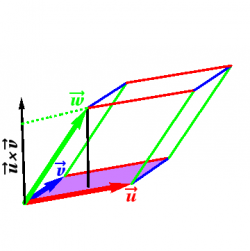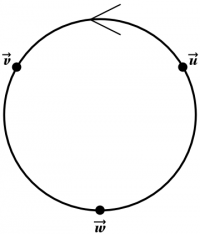The Triple Product
Just as a parallelogram is the region in the plane spanned by 2 vectors, a parallelepiped is the region in space spanned by 3 vectors. Each side of a parallelepiped is therefore a parallelogram.
What is the volume of a parallelepiped? The area of its base times its height. But the base of a parallelepiped is a parallelogram, and the area of a parallelogram is just the magnitude of the cross product of its vector sides. The height of a parallelepiped must be measured perpendicular to the base, which is the same direction (up to sign) as that of the cross product just computed. Thus, the height of a parallelepiped is just the projection of the remaining side onto the direction of the cross product, and projections are accomplished by taking a dot product. This construction is illustrated in Figure 1. Putting this all together, the (signed) volume $V$ of a parallelepiped spanned by the vectors $\uu$, $\vv$, $\ww$ is given by the (scalar) triple product \begin{equation} V = (\uu\times\vv)\cdot\ww \end{equation} which is positive if $\{\uu,\vv,\ww\}$ are right-handed, and negative otherwise.
The geometric argument used in the above construction shows that the volume, and hence the triple product, is independent (up to sign) of the order of the vectors used to define it. Taking signs into account, we have: \begin{equation} (\uu\times\vv)\cdot\ww = (\vv\times\ww)\cdot\uu = (\ww\times\uu)\cdot\vv \end{equation} with the other three orderings differing by a minus sign. The three orderings $\{\uu,\vv,\ww\}$, $\{\vv,\ww,\uu\}$, $\{\ww\,\uu,\vv\}$ are called cyclic permutations of each other; if one is right-handed, they are all right-handed. Note also that \begin{equation} \ww\cdot(\uu\times\vv) = (\uu\times\vv)\cdot\ww = (\ww\times\uu)\cdot\vv \end{equation} so that it doesn't matter whether the dot product is at the beginning or at the end. The cyclic nature of the triple product is summarized symbolically in Figure 2: So long as you write down the vectors in the order indicated by the arrow, it doesn't matter where you start, nor does it matter which product is a dot product, and which is a cross product. Of course, the parentheses do matter — you must evaluate the cross product before evaluating the dot product.
Using a symbolic determinant to compute the cross product, one quickly sees that the triple product is given by \begin{equation} (\vv\times\ww)\cdot\uu = \left| \matrix{ u_x& u_y& u_z\cr \noalign{\smallskip} v_x& v_y& v_z\cr \noalign{\medskip} w_x& w_y& w_z\cr} \right| \label{Triple} \end{equation} from which the cyclic nature of the triple product also follows immediately, using standard properties of the determinant.

